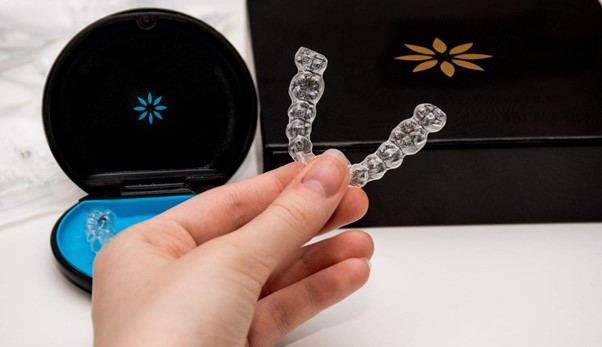Straightening your teeth with Invisalign is a popular choice, but many people wonder about the price. Invisalign costs explained can vary based on several factors, and knowing what influences the price can help you make a confident decision.
Unlike traditional braces, Invisalign offers a nearly invisible way to correct alignment issues. It’s comfortable, removable, and often requires fewer dental visits. But does the cost reflect its benefits? Let’s go over what determines Invisalign pricing and what you should expect when budgeting for treatment.
What Factors Influence Invisalign Costs?

The cost of Invisalign isn’t fixed. It depends on multiple factors, including the complexity of your case and your provider’s experience. Here are the main reasons why prices differ from one person to another:
1. Complexity of Treatment
Mild cases, like slight spacing issues, require fewer aligners. More severe misalignments or bite corrections take longer to treat, which increases the overall cost.
2. Length of Treatment
The number of aligners you need directly affects pricing. Shorter treatments, such as minor cosmetic fixes, tend to cost less than cases requiring over a year of adjustments.
3. Provider Expertise and Location
Highly experienced orthodontists may charge more for their expertise. Additionally, prices fluctuate by region—urban areas or high-cost-of-living locations may have higher fees compared to smaller towns.
4. Refinements and Additional Aligners
Some patients need refinements after completing their initial treatment. If extra aligners are required, this can add to the total cost.
5. Insurance Coverage
Many dental insurance plans offer partial coverage for Invisalign, similar to traditional braces. However, the amount covered varies based on your plan. Some policies cover up to 50% of the cost, while others may not cover Invisalign at all.
6. Payment Plans and Financing Options
Orthodontic offices often provide financing to make payments more manageable. Monthly installment plans can spread out the cost, making Invisalign more accessible.
Understanding these factors gives a clearer picture of what to expect. The next step is breaking down the actual cost range and comparing it to traditional braces.
Invisalign Costs Explained: A Breakdown of Pricing
The cost of Invisalign varies, but most patients can expect to pay between $3,000 and $8,000 for treatment. The exact amount depends on how complex the case is, how long treatment lasts, and what’s included in the overall plan.
Average Cost Range
- Mild to moderate cases: $3,000 – $5,500
- Moderate to complex cases: $5,500 – $8,000
- Express treatments (minor adjustments): $2,000 – $3,500
For comparison, here’s how Invisalign stacks up against traditional braces:
- Metal braces: $3,000 – $7,000
- Ceramic braces: $4,000 – $8,500
- Lingual braces (behind the teeth): $8,000 – $10,000
What’s Included in the Cost?
The total price of Invisalign typically covers:
✔ Initial consultation – Some orthodontists offer this for free, while others charge a small fee.
✔ Digital scans or impressions – Used to create custom aligners.
✔ Aligner trays – A full set of clear aligners for the treatment plan.
✔ Regular check-ins – Appointments to monitor progress and provide new aligners.
✔ Refinements (if needed) – Additional aligners in case adjustments are required.
✔ Post-treatment retainers – Help maintain results after treatment ends.
Are There Additional Costs?
Some orthodontic offices may charge separately for refinements or retainers, so it’s important to ask about these fees upfront. If a patient loses an aligner, there may be a replacement fee ranging from $100 to $200 per tray.
The overall cost of Invisalign depends on multiple factors, but for many, the benefits outweigh the investment. The next step is determining if Invisalign is truly worth the price based on its advantages.
Is Invisalign Worth the Investment?
Choosing Invisalign isn’t just about cost—it’s about the value it provides. Many people find that the benefits justify the price, especially when considering comfort, convenience, and aesthetics. Here’s what makes Invisalign a worthwhile choice for many patients.
Key Benefits That Make Invisalign Worth Considering
✔ Nearly Invisible Appearance – The clear aligners are discreet, making them ideal for adults and teens who want to straighten their teeth without drawing attention.
✔ Removable for Eating and Cleaning – Unlike traditional braces, Invisalign allows you to eat whatever you want. There are no food restrictions, and brushing and flossing remain easy.
✔ Fewer Orthodontic Visits – With no brackets or wires to adjust, Invisalign typically requires fewer in-office appointments. Some providers even offer remote monitoring options.
✔ More Comfortable Than Braces – The smooth plastic aligners don’t have sharp edges like metal braces, reducing irritation inside the mouth.
✔ Effective for Many Cases – Invisalign works well for mild to moderate alignment issues, including gaps, overcrowding, and bite problems.
Who Benefits the Most from Invisalign?
While Invisalign is an excellent option for many, some patients may see better results than others. Those who benefit the most include:
- Teens and adults looking for a discreet solution – Many prefer Invisalign because it blends with their natural smile.
- People with mild to moderate misalignment – Severe cases may require traditional braces.
- Patients who can commit to wearing aligners 20-22 hours a day – Consistency is key for effective results.
When Invisalign May Not Be the Best Choice
- Severe orthodontic cases – Some complex misalignments may require metal braces for better control.
- Patients who frequently remove their aligners – Not wearing them as directed can extend treatment time and reduce effectiveness.
- Those looking for the cheapest option – Traditional braces may be a more budget-friendly alternative, depending on insurance coverage and financing options.
For many patients, the convenience and comfort of Invisalign make it worth the investment. However, cost remains a concern, and knowing how to make treatment more affordable can help in making a final decision.
Ways to Make Invisalign More Affordable
Invisalign can be a significant investment, but there are ways to reduce the cost and make treatment more manageable. Many orthodontic offices offer financing, and some insurance plans cover a portion of the expense. Here’s how to make Invisalign more affordable.
1. Check Your Insurance Coverage
Some dental insurance plans include orthodontic benefits that apply to Invisalign. Coverage varies, but many plans pay a percentage of the cost or a fixed amount, often up to $1,500 – $3,000.
✔ How to check: Contact your insurance provider to ask if Invisalign is covered under your plan.
✔ What to look for: Some policies cover traditional braces but exclude Invisalign, so it’s important to verify the details.
2. Use an FSA or HSA
Flexible Spending Accounts (FSA) and Health Savings Accounts (HSA) allow you to use pre-tax dollars for medical expenses, including Invisalign.
✔ FSAs – Offered through employers, with a yearly contribution limit (usually around $3,000).
✔ HSAs – Available to those with high-deductible health plans, with higher contribution limits.
Using these accounts can lower out-of-pocket costs by reducing taxable income.
3. Ask About Payment Plans
Most orthodontists offer payment plans that break the total cost into monthly installments. Some plans are interest-free, while others may have low-interest financing.
✔ No-interest financing – Many providers allow you to spread payments over 12-24 months with no extra fees.
✔ Third-party financing – Companies like CareCredit offer extended payment options for medical expenses.
4. Look for In-House Discounts or Promotions
Some orthodontic offices offer discounts for:
✔ Paying in full upfront – Some providers reduce the total cost if payment is made at the start of treatment.
✔ Family plans – Discounts may be available if multiple family members receive Invisalign treatment.
✔ Seasonal promotions – Some offices run limited-time discounts throughout the year.
5. Consider an Orthodontic School
Dental schools with orthodontic programs sometimes offer Invisalign at a lower cost. Treatment is supervised by experienced professionals, making it a budget-friendly option.
By exploring these options, Invisalign can become more affordable without sacrificing quality. The next step is understanding the most common questions people have about Invisalign costs.
FAQs: Invisalign Costs Explained
Understanding Invisalign costs can feel overwhelming, and many people have similar concerns about pricing, coverage, and hidden fees. Here are answers to some of the most common questions.
1. Does insurance cover Invisalign?
It depends on your dental insurance plan. Some policies cover Invisalign just like traditional braces, offering partial reimbursement—usually $1,500 to $3,000. Others may only cover metal braces or exclude clear aligners altogether. Contact your provider to confirm your benefits.
2. Are there hidden costs with Invisalign?
Most providers include everything in the initial quote, but it’s always good to ask about:
✔ Refinement aligners – Some cases require additional aligners if teeth don’t shift as planned.
✔ Retainers – Many orthodontists charge separately for post-treatment retainers.
✔ Lost or damaged aligners – Replacement fees range from $100 to $200 per tray.
3. How do Invisalign costs compare to braces?
Invisalign generally costs $3,000 to $8,000, which is similar to or slightly higher than traditional braces. Metal braces typically range from $3,000 to $7,000, while ceramic braces can be $4,000 to $8,500. The final cost depends on treatment complexity, duration, and provider fees.
4. Can I use an HSA or FSA to pay for Invisalign?
Yes. Health Savings Accounts (HSA) and Flexible Spending Accounts (FSA) allow you to use pre-tax dollars to pay for Invisalign. This can reduce the overall financial burden by lowering taxable income.
5. What happens if I lose an aligner?
If you misplace an aligner, contact your orthodontist immediately. Some providers offer a limited number of free replacements, while others charge per tray. In the meantime, wearing the previous aligner can help prevent teeth from shifting.
6. Is Invisalign cheaper for minor corrections?
Yes. Shorter treatments, such as Invisalign Express, are designed for minor adjustments and typically cost between $2,000 and $3,500. More complex cases that require longer treatment will be on the higher end of the pricing range.
These FAQs provide a better idea of what to expect when budgeting for Invisalign. The final step is deciding if the investment is right for you.
Conclusion
Invisalign offers a convenient and nearly invisible way to straighten teeth, but the cost is a major consideration. Prices typically range from $3,000 to $8,000, depending on treatment complexity, provider experience, and location. While it may seem expensive, many find the benefits—comfort, aesthetics, and flexibility—well worth the investment.
For those concerned about affordability, there are ways to reduce costs. Insurance coverage, FSAs, HSAs, and flexible payment plans can make Invisalign more accessible. Some orthodontists also offer discounts for upfront payments or multiple family members undergoing treatment.
With Invisalign costs explained, you now have a clearer understanding of what influences pricing and how to make it more manageable. If you’re considering Invisalign, consulting with a provider can give you a personalized estimate and help you determine if it’s the right choice for your smile.
Take the Next Step Toward a Confident Smile
Understanding Invisalign costs is important, but so is choosing the right orthodontic provider. At Bowers Orthodontic Specialists, we offer expert care, transparent pricing, and personalized treatment plans to help you achieve the smile you’ve always wanted.
Our team provides a stress-free experience, ensuring you get the best results in a comfortable setting. From Invisalign to traditional braces, we create customized solutions for children, teens, and adults. Schedule a consultation today to explore your options and find the right treatment for you.




